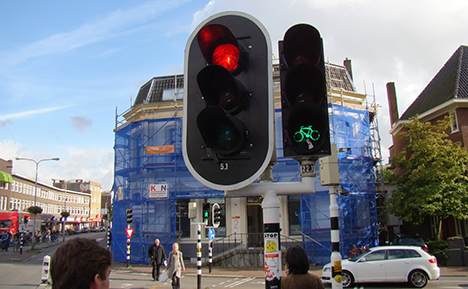International Bicycle Signal Resources
Prior to the issuance of FHWA’s IA-16 in December 2013, use of bicycle signal faces within the United States was limited to only a few jurisdictions. Despite their subsequent use, specific design limitations remain for engineers and design practitioners seeking to use bicycle signals at intersections. Agencies may be reluctant to adopt using bicycle signals without their definition in state law. Countries in Europe and Asia offer decades of experience on how to improve the safety, convenience, and comfort of cycling facilities. The Netherlands, Germany, Denmark, and the United Kingdom—to name a few—are examples of countries with exceptional bicycle signal infrastructure in Europe. Japan and China also have significant deployments of bicycle infrastructure. Furthermore, Canada has also made significant strides in improving cycling safety through increased cycling infrastructure and bicycle signal priority. In order to gain another perspective of the design and operations of bicycle signals in the international context, several international design resources are provided for practitioners in the United States to consider.
The Netherlands - CROW Design Manual for Bicycle Traffic - Section 6.3.3.2 Traffic Lights (2016)
 Figure 3. Example of a bicycle signal face at an intersection with many modes in Utrecht, The Netherlands. Source: Rock Miller.
Figure 3. Example of a bicycle signal face at an intersection with many modes in Utrecht, The Netherlands. Source: Rock Miller.The adopted manual for Dutch cycling policy and design, CROW Design Manual for Bicycle Traffic presents a wide array of arguments, empirical data, ideas, and tips intended to assist designers in affording the bicycle a full place in the transportation system. The content of the CROW manual focuses on the design aspects of cycling facilities to accommodate the persistent volume of bicycle traffic and the anticipated growth of bicycle use throughout the Netherlands. It should be noted that there are many regional differences and preferences for facilitating motor vehicle and bicycle traffic flow through signalized intersections.
Generally, the Dutch consider traffic signals as a less sustainable solution over roundabouts or grade-separated crossings. Traffic signals in the Netherlands are only considered when the safety of a particular junction or crossing is worsened by the volume or speed of the traffic flow. Section 6.3.3.2 of the manual contains various criteria and design requirements for traffic signals and highlights the fundamental Dutch principles for policy and management for cycle-friendly traffic control. The CROW manual highlights three principal criteria for consideration of safe and efficient bicycle traffic flow through intersections.
- Cyclists’ waiting time vs. probability of having to stop
- An average wait time of 15 seconds or less is deemed good.
- An average wait time of 20 seconds or more is deemed bad.
- Priority roads provide a maximum average wait time of < 90 seconds for rural areas and < 100 seconds for urban areas. Hence, from the perspective of a cyclist, introducing a traffic signal is seldom a good idea in exchange for a roundabout or grade separated crossing.
- Cycle time (or cycle length)
- Generally, shorter cycle times, preferably not longer than 90 seconds, will improve bicycle traffic flow and other modal flow as well.
- Partial conflicts between car and bicycle
- Due to lack of space, partial conflicts may be desirable in order to shorten wait times for all modes.
- The manual gives general recommendations for discouraging partial conflicts between car and bicycle traffic under various volume or geometric conditions.
A thorough analysis should consider each of these criteria within the Dutch context. The CROW manual also provides schematic design concepts for facilitating the flow of cyclists at a signalized intersection and lists various design possibilities for combining cycle-friendly measures at traffic lights.
The CROW Design Manual for Bicycle Traffic was originally published in the 1970s, but has been recently revised and published, including in English, in 2016. Many traffic signal concepts presented in this manual may not be directly applicable to U.S. streets due to the uniqueness of the Dutch approach, but other details including lane widths, turning radii, and cycling infrastructure concepts to name a few, can be informative for U.S. planning and design practices. This design manual is not available in digital format at this time.
For additional information, please visit: https://crowplatform.com/product/design-manual-for-bicycle-traffic/
Advantages
- The design guidance is very thorough and represents practices that have been refined over decades of cycling experience.
Disadvantages
- Not all design information is applicable to the United States. Examples include signal face design and signal face size.
- The manual is not available digitally.
United Kingdom (U.K.) Department for Transport Cycle Infrastructure Design
The Department of Transport in the U.K. recently released the Cycle Infrastructure Design manual in July 2020. It is a comprehensive document including both planning and design principles as well as transitions and parking considerations. The manual is viewable here: https://assets.publishing.service.gov.uk/government/uploads/system/uploads/attachment_data/file/951074/cycle-infrastructure-design-ltn-1-20.pdf